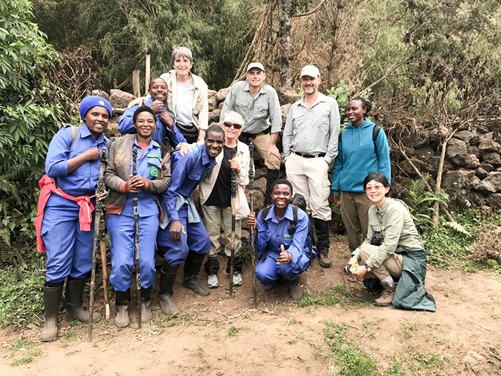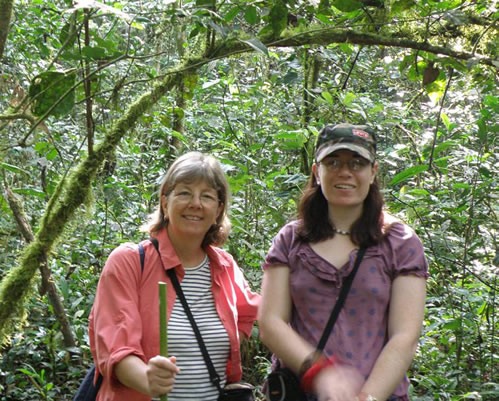Wondering about what to wear for gorilla trekking in Uganda? Gorilla trekking is one of the most exciting and adventurous wildlife activities. The activity involves hiking deep in the Africa’s jungles in search of gorillas. Gorillas are fascinating primates because they behave and resemble humans the most. Watching a family of gorillas is like going back in time to when the first humans roamed earth. Unlike chimpanzees, gorillas appear calm and gentile. The Silverback often leads by example and charisma. He only resorts to aggression when things get out of hand. There are 4 subspecies of gorillas – western lowland gorillas, cross river gorillas, eastern lowland gorillas and mountain gorillas. Eastern lowland gorillas are the largest gorilla subspecies followed closely by mountain gorillas. Most tourists come to Africa to track mountain gorillas but one can also track the Eastern and Western lowland gorilla.
 Most of the gorilla species are critically endangered because of habitat loss, poaching and pet trade. Gorilla trekking is an important conservation tool because it helps generate funds needed to patrol the parks and pay park Rangers. Gorilla trekking also brings tourists hence providing jobs for communities living close to the gorilla parks. People are less likely to hurt wildlife is they see the benefits of having them around. Tourists also help raise awareness of the need to protect the primates once they get back to their countries. Most gorilla trekking expeditions are carried out in Uganda, Rwanda and the Democratic Republic of Congo. In Rwanda, mountain gorillas can be spotted in the volcanoes national park. In Uganda one can choose between gorilla trekking Bwindi impenetrable National Park or Mgahinga Gorilla National park. The Democratic Republic of Congo is special because one can see both Eastern lowland and mountain gorillas. The Mountain gorillas of Congo are found in Virunga National park while the Eastern lowland gorilla can be seen in Kahuzi Biega national Park.
Most of the gorilla species are critically endangered because of habitat loss, poaching and pet trade. Gorilla trekking is an important conservation tool because it helps generate funds needed to patrol the parks and pay park Rangers. Gorilla trekking also brings tourists hence providing jobs for communities living close to the gorilla parks. People are less likely to hurt wildlife is they see the benefits of having them around. Tourists also help raise awareness of the need to protect the primates once they get back to their countries. Most gorilla trekking expeditions are carried out in Uganda, Rwanda and the Democratic Republic of Congo. In Rwanda, mountain gorillas can be spotted in the volcanoes national park. In Uganda one can choose between gorilla trekking Bwindi impenetrable National Park or Mgahinga Gorilla National park. The Democratic Republic of Congo is special because one can see both Eastern lowland and mountain gorillas. The Mountain gorillas of Congo are found in Virunga National park while the Eastern lowland gorilla can be seen in Kahuzi Biega national Park.
Whereas gorilla trekking is a fascinating activity, one needs to be both mentally and physically prepared to deal with the challenges that arise while searching for the primates. We have put together a list of things to consider packing and wear while tracking gorillas. You do not have to pack everything suggested in the following chapters. Acquire only those you think will be useful. Before going to the packing list, you might find our article about the gorilla trekking rules useful.
What to Wear for Gorilla Trekking – Packing List for gorilla trekking
![]() Gorilla Permit and Passport: These two documents must be with you at all times. The gorilla permit and passport must be present at the head offices for verification so that the authorities can ascertain whether a traveler is eligible to track the gorillas. The passport is presented to the park officials to know if the permit is yours and that you are old enough to track the gorillas. According to the gorilla trekking rules, one needs to be at least 15 years to track gorillas. Gorilla groups are allocated based on the age and the physical fitness of travelers. A passport will therefore help determine if you get an easy or harder trek
Gorilla Permit and Passport: These two documents must be with you at all times. The gorilla permit and passport must be present at the head offices for verification so that the authorities can ascertain whether a traveler is eligible to track the gorillas. The passport is presented to the park officials to know if the permit is yours and that you are old enough to track the gorillas. According to the gorilla trekking rules, one needs to be at least 15 years to track gorillas. Gorilla groups are allocated based on the age and the physical fitness of travelers. A passport will therefore help determine if you get an easy or harder trek
Hiking Boots: As we mentioned earlier, gorilla trekking requires one to hike for long distances in dense forest. The forest trails can be muddy and steep hence presenting challenges to trackers. With the challenges in mind, a tracker needs to acquire shoes with good grip/traction and can cover the feet/ankles. With such shoes, one can easily walk for long hours in the forest without slipping or getting pierced by thorns.
Clothing: Not all clothes are suitable for the African jungle. The clothes for gorilla trekking should be made of light material and water proof. They should cover most parts of your body to protect you from thorns and sharp vegetation in the jungle. A tracker must wear a long sleeved top and a long pair of trousers. A tracker must also be selective of the colors. He or she should choose what is known as jungle colors – cream, brown, grey and dark green. Very bright colors make you stand out and could attract unnecessary attention from the gorillas.
 Raincoat and sweater: The weather in most of the gorilla parks is very unpredictable. You can start the hike when the sun is bright and the rains come suddenly. As a tracker, you must carry a rain jacket before going out to look for the gorillas. The Volcanoes and Mgahinga National Park are located in areas of high altitude. It can get very cold especially during the wet season. A sweater will help you keep warm during and after gorilla trekking. You also need a cap to protect your head from sunlight and sunglasses to protect your eyes from the same. Hand gloves will help protect your hands from sharp tree branches.
Raincoat and sweater: The weather in most of the gorilla parks is very unpredictable. You can start the hike when the sun is bright and the rains come suddenly. As a tracker, you must carry a rain jacket before going out to look for the gorillas. The Volcanoes and Mgahinga National Park are located in areas of high altitude. It can get very cold especially during the wet season. A sweater will help you keep warm during and after gorilla trekking. You also need a cap to protect your head from sunlight and sunglasses to protect your eyes from the same. Hand gloves will help protect your hands from sharp tree branches.
Insect Repellents: Mountain gorillas live in countries lying in the tropics with many irritating insects like mosquitos. We recommend that you carry an insect repellent to protect yourself from insect bites. Try to pack deodorants, perfumes, shavers and hand sanitizers so that you can look and smell good during your trip. You should even consider packing toilet paper, wipes, tooth paste and a tooth brush.
Snacks, packed lunch and drinking water: Gorilla trekking takes between 2 to 6 hours depending on the group you will be tracking. You might find yourself exhausted, thirsty and hungry. You will therefore need drinking water, energy drinks and light snacks for lunch. The packed lunch and water can be arranged from your lodge but if that is not possible, then you can buy them from a supermarket in the nearby towns.
Walking stick: Gorilla tracking is very unpredictable depending on which national park you visit. The trails are not demarcated and you will find yourself hiking through thick forests, mountain slopes, river streams and valleys. We recommend that you acquire a suitable hiking stick to support and help you hike through hills and valleys. Basic walking sticks are given free of charge at the starting point but you can acquire higher-end ones at a cost.
Camera with a great focus, strong battery and memory: Why would you go for a gorilla trekking without taking any photos. Gorilla trekking is a very special wildlife experience and you need to have both mental and physical memories that you can show your friends/family. A very good camera is important to capture the primates but also the beautiful volcanoes and forest creatures. Do not use flash cameras while with the gorillas.
Binoculars: Gorilla trekking is not all about gorillas. You will be encountering pristine wilderness with an amazing collection of wildlife including small primates, butterflies, moths, birds, antelopes, forest hogs and much more. A binocular will help you spot all these creatures as you search for the gorillas.
Phone simcard: In order to keep in touch with your friends and family while in Africa, you need to acquire a local simcard. The simcard will help you make calls back home and also gain access to internet even while out in the jungle.
 Porters: Are you planning to travel with a heavy bag or equipment (video cameras, binoculars and other gadgets)? If the answer is yes, then you might need to hire a porter to relieve you of the burden of carrying heavy stuff. The porters will also lend a hand during the more difficult sections of the hike. Porters consists of students looking for school fees, former poachers, fathers and mothers. By hiring their services, you are indirectly making a difference in their lives. Porters are available just after the briefing or at the starting point of the trek. The services of a porter costs about $15.
Porters: Are you planning to travel with a heavy bag or equipment (video cameras, binoculars and other gadgets)? If the answer is yes, then you might need to hire a porter to relieve you of the burden of carrying heavy stuff. The porters will also lend a hand during the more difficult sections of the hike. Porters consists of students looking for school fees, former poachers, fathers and mothers. By hiring their services, you are indirectly making a difference in their lives. Porters are available just after the briefing or at the starting point of the trek. The services of a porter costs about $15.
Tipping: One thing you will notice throughout your gorilla tour is the dedication, enthusiasm and friendliness of the people you meet. The people could include Park rangers, hotel personnel, Drivers and Guides. It’s a nice gesture to reward them with tip if they go out of their way to make your time memorable in Africa. Tip of $10 would be great. Only give out tip if you want to.
Other essential items for packing: Apart from the items we already mentioned, there are some other essential items that you should consider including in your gorilla trekking packing list. They include travel maps, a guide book, an itinerary from your tour company, cash or a visa card for buying souvenir. A traveler should also consider traveling with a first-aid kid and medications for any lifestyle diseases they have.


